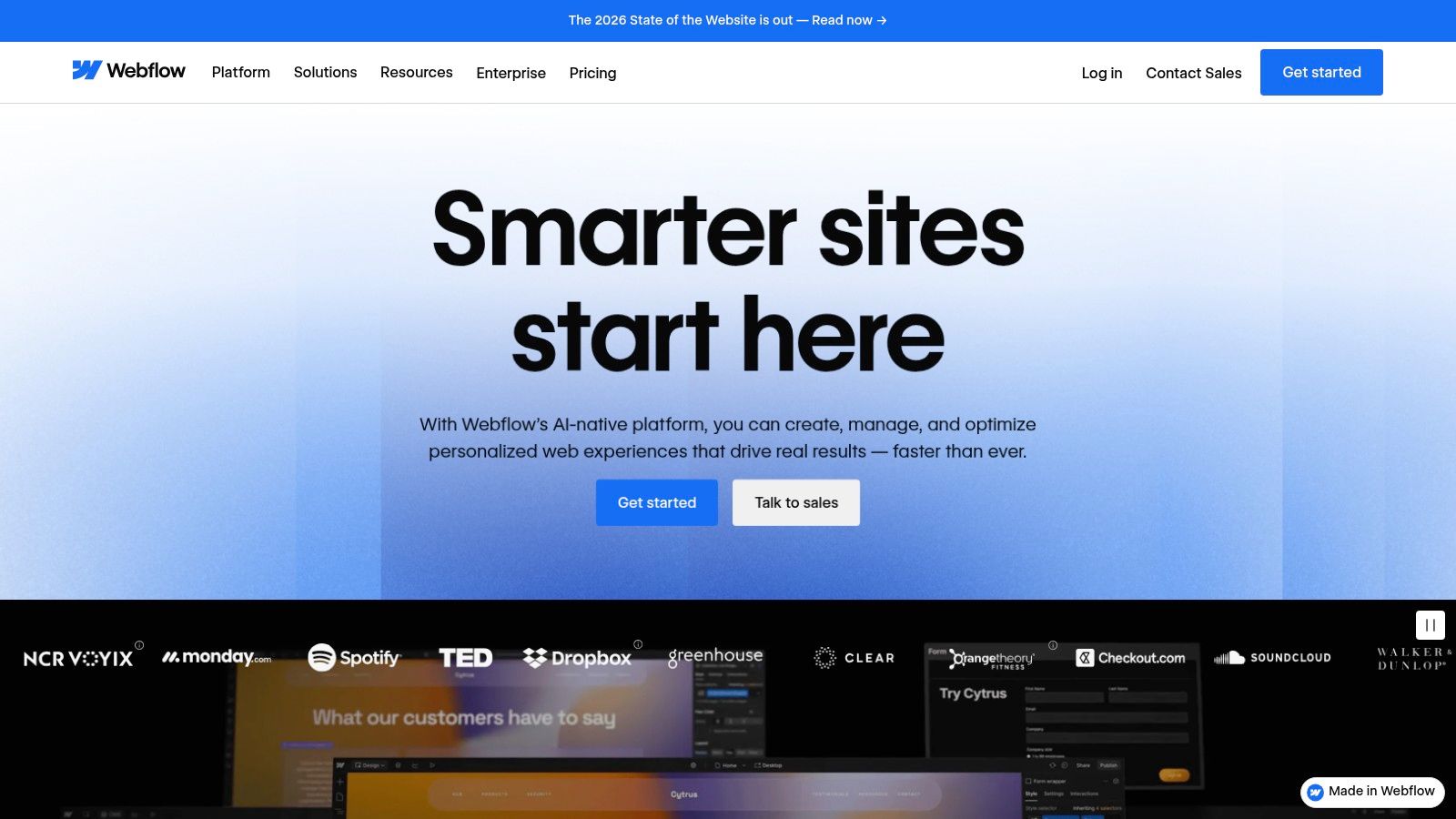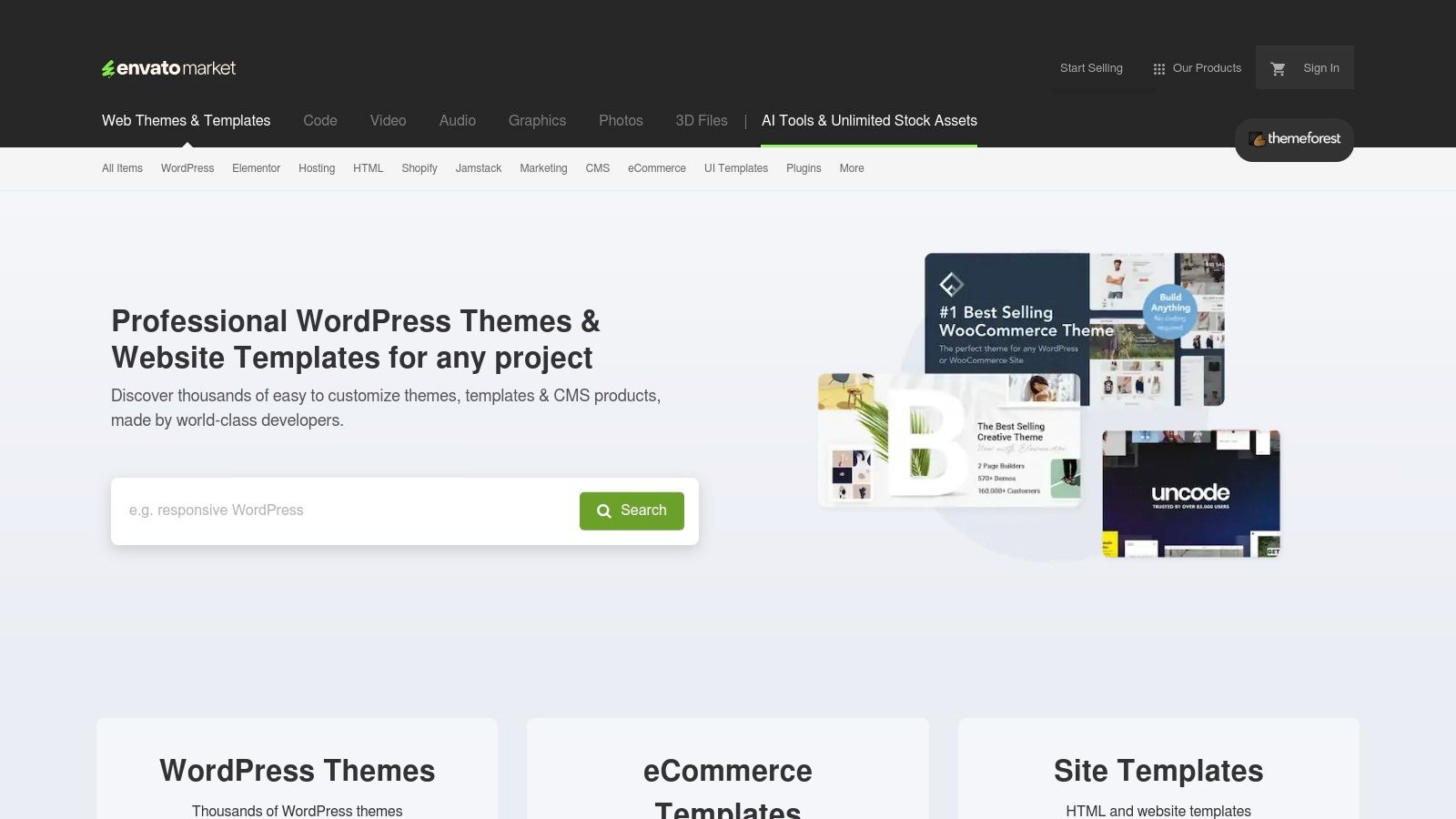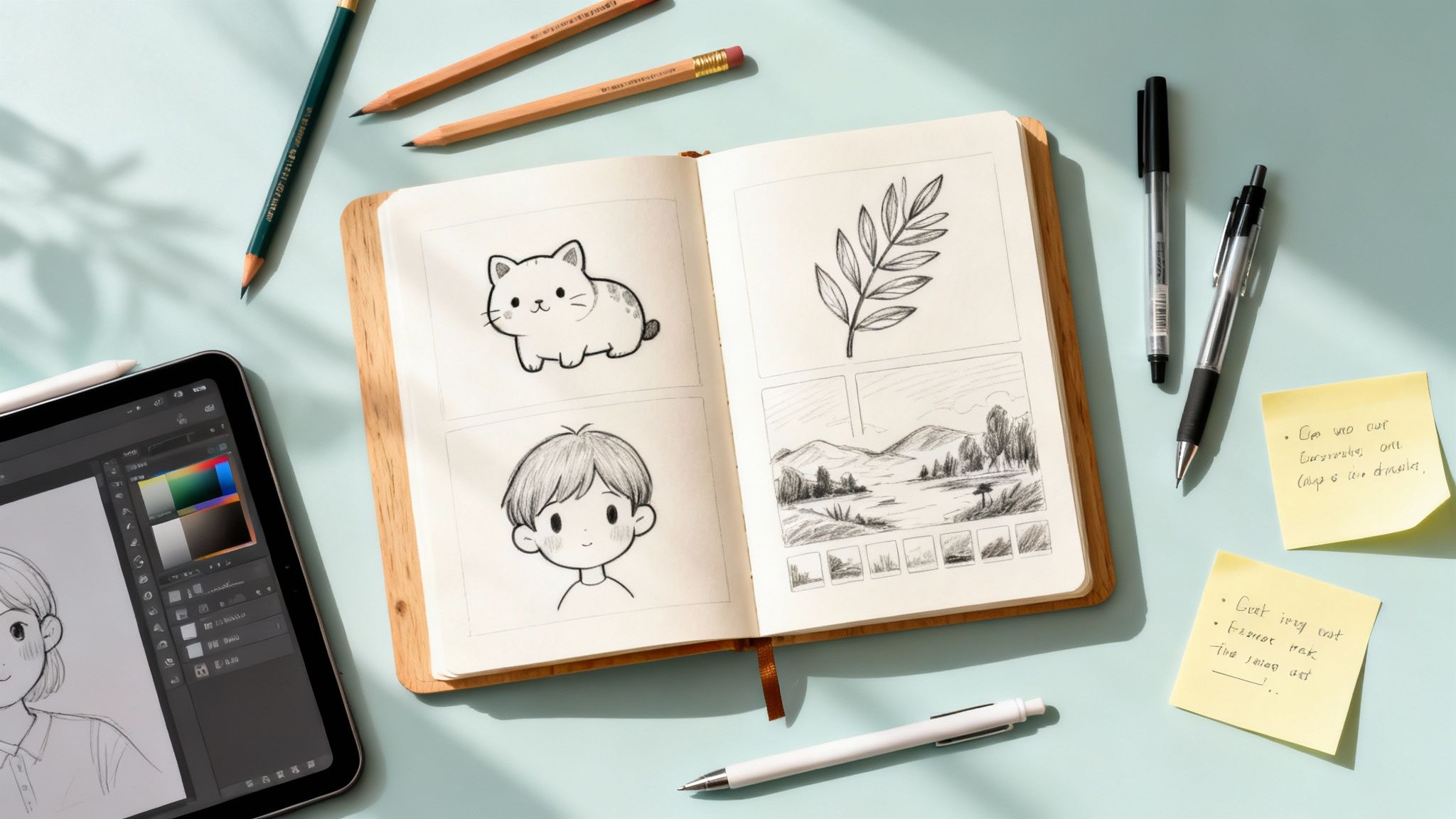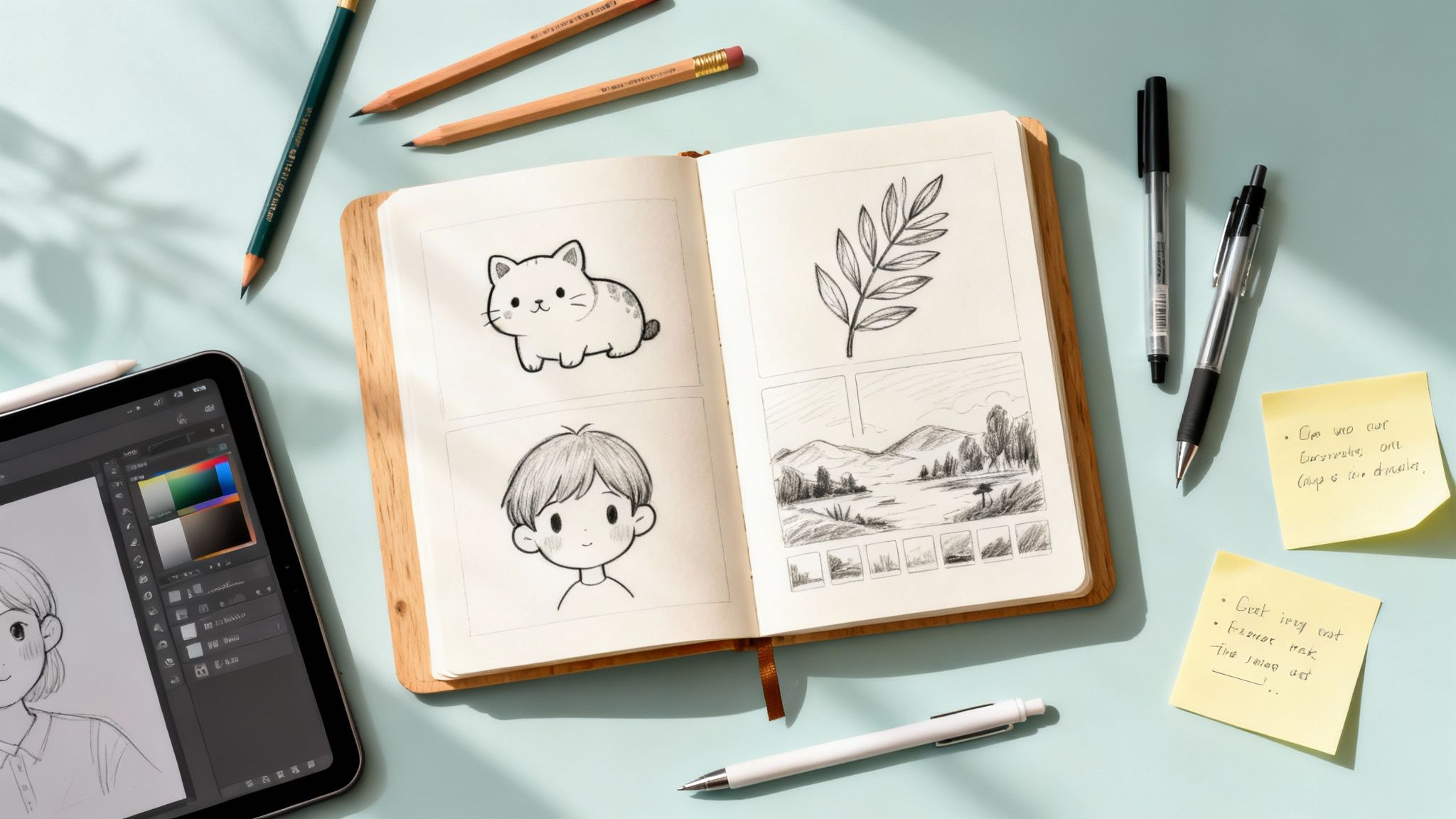An exceptional art director portfolio does more than just display beautiful visuals; it tells a strategic story of creative leadership, problem-solving, and vision. It demonstrates how you translate a brief into a compelling campaign that drives results and showcases your unique creative fingerprint. But how do you build a portfolio that communicates that level of expertise?
Before you begin, it’s crucial to analyse what works for the best in the business. That's where this guide comes in. We will break down standout art director portfolio examples, highlighting the specific strategies, design choices, and narrative techniques that make them so effective. You will learn not just what they did, but why it works and how you can apply those insights to your own work. For a comprehensive guide on building your online presence, explore insights on how to create a portfolio website that effectively attracts potential clients.
Ready to elevate your creative process in a responsible and secure environment? Virtuall's Creative AI OS is an enterprise-grade solution that unifies 3D model, image, and video generation in a single, compliant workspace. Move from concept to final asset faster than ever while ensuring your studio's projects stay organised and secure. If you haven't generated anything yet, you can try it for free and experience the power of a streamlined, safe creative workflow.
1. Behance
Behance isn't a single portfolio but rather the world’s largest creative network and a foundational resource for anyone looking to study thousands of high-calibre art director portfolio examples. Owned by Adobe, it functions as a vast, free-to-browse gallery where professionals from every creative discipline, including advertising, branding, and interactive design, showcase their best work.
For art directors, Behance is an indispensable tool for competitive benchmarking and inspiration. Its powerful search and filtering capabilities allow you to quickly surface relevant projects, follow influential creatives, and curate mood boards. The platform’s true value, however, lies in its emphasis on process. Many creators don't just post final deliverables; they share detailed case studies, behind-the-scenes sketches, and strategic write-ups that reveal the why behind their creative decisions.
Strategic Analysis
Behance’s unique strength is its sheer volume and diversity. Unlike a curated gallery, it provides a real-time, unfiltered view of current industry trends, tools, and presentation styles. This scale makes it a powerful educational platform.
Key Takeaway: You can use Behance to deconstruct successful projects piece by piece. Analyse how other art directors structure their case studies, articulate their creative rationale, and present campaign assets. This is market research and portfolio development in one.
Actionable Insights
To get the most out of the platform, move beyond passive browsing and use its tools strategically.
- Deep Dive with Filters: Don't just search for "art director". Use filters for specific tools (e.g., Photoshop, Cinema 4D), creative fields (e.g., "Branding," "Advertising"), and locations to narrow your focus.
- Study the "Featured" Galleries: The "Curated Galleries" are Behance’s way of highlighting top-tier work. Analyse what these projects have in common, from storytelling structure to visual execution.
- Analyse Presentation, Not Just Work: Pay close attention to how projects are presented. Notice the use of mockups, motion graphics, and detailed project narratives. The presentation is as important as the work itself.
While the platform is a goldmine for inspiration, remember that the quality can vary. Use the curated sections and follow established agencies and directors to ensure you’re learning from the best. As you browse, consider how emerging technologies can elevate your own work; many creators on Behance are already exploring how AI tools for designers are shaping modern creative workflows.
Website: https://www.behance.net
2. Dribbble
Dribbble is a major online community and marketplace where designers showcase user-friendly snapshots of their work. While often associated with UI/UX and illustration, it's a valuable platform for sourcing art director portfolio examples, especially for those focused on brand identity, digital products, and campaign visuals. Its format prioritises quick, high-impact visuals known as “shots,” making it an excellent source for rapid inspiration and trend-spotting.
For art directors, Dribbble serves a dual purpose: it’s a place to discover emerging visual styles and a direct channel to attract clients and job opportunities. Unlike platforms that demand extensive case studies for every entry, Dribbble allows creatives to share work in progress, one-off concepts, and specific components of larger projects. This makes it a more dynamic, real-time feed of the creative industry's pulse.
Strategic Analysis
Dribbble’s core strength is its focus on aesthetic execution and immediate visual appeal. The "shot" format forces designers to distil the most compelling aspect of a project into a single, digestible image. This is particularly useful for art directors looking to validate visual directions or get quick feedback on a specific design element without building a full case study.
Key Takeaway: Use Dribbble not for in-depth strategic breakdowns, but for curating a "swipe file" of top-tier visual execution. Analyse colour palettes, typography pairings, and composition techniques from the most popular shots to inform your own day-to-day design decisions.
Actionable Insights
To leverage Dribbble effectively, you must understand its community dynamics and use its features to cut through the noise.
- Follow Collections and Tags: Instead of a general search, follow curated "Collections" and specific tags like "art direction," "brand identity," or "motion design" to see highly-regarded work in your niche.
- Analyse "Popular" Shots: The "Popular" filter reveals what the community currently values. Study these shots to understand trending aesthetics, but also be critical-what works as a single shot may not translate to a full campaign.
- Look Beyond the Shot: Many designers link their Dribbble shots to more comprehensive case studies on Behance or their personal sites. Use the shot as a gateway to discover deeper project narratives.
While the platform is excellent for visual discovery, its emphasis on single images can sometimes under-represent the strategic thinking and problem-solving that define senior art direction. Many advanced features, such as enhanced profile visibility and client matching, are also gated behind a Dribbble Pro subscription.
Website: https://dribbble.com
3. Adobe Portfolio
Adobe Portfolio is a streamlined website builder designed specifically for creatives to build and publish their own online portfolios. Included with most Adobe Creative Cloud plans, it removes many of the technical hurdles of website creation, allowing art directors to focus on what matters: showcasing their work. Its key advantage is its deep, native integration with the Adobe ecosystem, particularly Behance and Creative Cloud.
For an art director already using Adobe tools, this platform offers a remarkably efficient path to a professional-looking site. You can synchronise projects directly from your Behance profile with a single click, instantly populating your new portfolio with existing case studies. This seamless workflow is a major draw for busy professionals who need a polished, personalised web presence without the learning curve of more complex builders.
Strategic Analysis
Adobe Portfolio’s strength lies in its simplicity and integration. It's not trying to be an all-in-one website solution like Webflow or Squarespace; instead, it provides a curated set of clean, visually-driven templates that put the creative work front and centre. This focus makes it an excellent choice for creating dedicated art director portfolio examples that are easy to navigate and aesthetically pleasing.
Key Takeaway: Use Adobe Portfolio when your primary goal is speed, simplicity, and a direct link to your Behance projects. It’s the path of least resistance from showcasing work on a social network to owning a personalised domain.
Actionable Insights
To maximise the platform's potential, leverage its unique integrations and design-focused features.
- Leverage Behance Sync: If you already maintain a Behance profile, use the one-click sync feature. This saves hours of work and ensures consistency between your public profile and your personal website. You can then customise the presentation on your Adobe Portfolio site.
- Customise Your Grid: Don't just stick with the default template layout. Experiment with different grid styles, cover image designs, and typography using the built-in Adobe Fonts library to give your portfolio a unique, branded feel.
- Optimise for Case Studies: The templates are built to support rich case studies. Use this to your advantage by creating dedicated pages for your most important projects, complete with detailed write-ups, full-bleed imagery, and embedded videos.
While it lacks the advanced customisation of other platforms, its ease of use makes it a powerful and accessible tool. The platform is not sold separately and requires an eligible Creative Cloud subscription. As you build your case studies, consider how new technologies can enhance them; many creatives are now using AI-powered tools to generate mockups and concept art that strengthen their narratives.
Website: https://portfolio.adobe.com
4. Squarespace
Squarespace is not an individual portfolio but a popular all-in-one website builder that has become a go-to platform for creatives building polished art director portfolio examples. Its primary appeal lies in its curated selection of modern, visually-driven templates that allow art directors to launch a professional, branded site quickly without needing to write a single line of code. It packages hosting, analytics, and custom domain support into one subscription.
For art directors who prioritise a clean, premium aesthetic and ease of use, Squarespace offers a streamlined solution. The platform excels at creating structured, elegant case studies with strong typography and intuitive layouts. Features like password-protected pages are ideal for showcasing confidential work or projects under NDA, while built-in blogging and e-commerce tools allow for personal branding and selling prints or digital assets directly.

Strategic Analysis
Squarespace’s strength is its balance of high-quality design and user-friendly functionality. Unlike more complex builders, it guides users toward good design choices, making it difficult to create a poorly structured site. This "design-in-a-box" approach ensures a high standard of presentation, which is critical for an art director's portfolio.
Key Takeaway: Use Squarespace to create a highly polished, low-maintenance brand hub. Its all-in-one nature means you can focus on curating your work and telling compelling stories instead of managing technical backend tasks.
Actionable Insights
To maximise Squarespace’s potential, go beyond simply adding images to a template. Customise strategically to reflect your unique creative identity.
- Select Templates by Function: Don’t just choose a template for its look. Analyse its structure. Does it prioritise large hero images, long-form case studies, or a grid-based overview? Pick one that aligns with how you want to present your projects.
- Customise Typography and Spacing: Use the Style Editor to fine-tune fonts, colours, and spacing. Small, deliberate adjustments can elevate a standard template into a bespoke-feeling portfolio that reflects your personal aesthetic.
- Leverage Project Pages for Case Studies: Use Squarespace's "Project" or "Portfolio" page types to build out detailed case studies. Combine image blocks, text, and video to walk recruiters through your creative process, from initial brief to final execution.
While Squarespace offers fantastic templates, achieving a truly unique look might require some effort. If you're considering using Squarespace for your portfolio, you might also explore professional Squarespace Website Design services to help create a polished online presence. Its plans vary, so ensure the tier you choose includes the features you need, such as lower transaction fees or advanced analytics.
Website: https://www.squarespace.com
5. Webflow
Webflow is a professional, no-code web design platform that gives art directors unparalleled creative control without needing to write code. While it's a tool for building your own site, its true value for research comes from the public Webflow Showcase, a massive gallery of live websites built by its community. This makes it an exceptional resource for studying finished, functional art director portfolio examples that go beyond static mockups.
Unlike template-driven builders, Webflow empowers designers to create custom interactions, complex animations, and pixel-perfect layouts. This means the portfolios you find in the Showcase are often more dynamic and creatively ambitious. For art directors looking to build a portfolio that feels completely bespoke, Webflow provides the tools, and its Showcase provides the inspiration and technical proof of what's possible.

Strategic Analysis
Webflow’s key strength is its ability to bridge the gap between simple website builders and custom-coded solutions. This allows for portfolios that are not just visually compelling but also rich in interactive storytelling. The platform’s robust Content Management System (CMS) is particularly well-suited for creating detailed, long-form case studies that blend text, imagery, and motion seamlessly.
Key Takeaway: Use the Webflow Showcase to see how top-tier art directors are using advanced web animations and interactions to guide the user’s journey through a project. This is a masterclass in digital storytelling and user experience design.
Actionable Insights
To leverage Webflow effectively, think of it both as a source of inspiration and a potential platform for your own portfolio. The learning curve is steeper than simpler tools, but the payoff is a highly differentiated online presence.
- Filter the Showcase: Use the "Made in Webflow" Showcase and filter by categories like "Portfolio" and "Design" to find relevant examples. Look for sites that have been cloned, as this allows you to reverse-engineer their structure in the Webflow Designer.
- Analyse Interactive Elements: Pay close attention to scroll-triggered animations, page transitions, and hover effects. Ask yourself how these elements enhance the project narrative rather than just serving as decoration.
- Evaluate the CMS for Case Studies: When viewing a portfolio, consider how it is structured. A strong Webflow portfolio uses the CMS to create rich, repeatable layouts for case studies, a crucial skill which requires excellent project management for designers.
While you can start designing for free, publishing a site requires a paid plan. The investment provides hosting and unlocks the full potential of the platform, making it a powerful choice for art directors who want their portfolio itself to be a standout piece of work.
Website: https://webflow.com
6. ThemeForest (Envato Market)
While not a portfolio itself, ThemeForest is a vast marketplace where you can find the foundational structure for countless art director portfolio examples. As part of the Envato Market, it offers thousands of professionally designed themes and templates for platforms like WordPress and Webflow. This makes it a crucial resource for creatives who want a high-end, custom-looking website without needing to code it from scratch.

For art directors, ThemeForest serves as both a practical tool and a source of inspiration. You can browse live demos to see how different layouts, animations, and case study grids function in a real-world context. This allows you to evaluate what presentation styles best suit your work, whether you need a minimalist grid, a cinematic full-screen video, or an interactive project showcase. The one-time purchase model makes it an accessible option for building a powerful portfolio.
Strategic Analysis
ThemeForest’s primary strength is its ability to democratise high-quality web design. It provides a shortcut to a polished and functional portfolio, freeing up your time to focus on what matters most: curating and articulating the creative work within it. The platform also offers a clear view of current web design trends, as the most popular themes often reflect what is resonating with a broad audience.
Key Takeaway: Use ThemeForest to fast-track your portfolio's technical development. Instead of building from zero, you can select a premium, well-supported theme that already includes the features you need, like project filtering, video integration, and responsive design.
Actionable Insights
To leverage ThemeForest effectively, approach it with a clear strategy rather than just browsing aimlessly.
- Filter for Your Needs: Start by filtering for your preferred platform (e.g., WordPress). Then, use tags like "portfolio," "creative," "minimal," or "agency" to find themes specifically built for visual showcases.
- Scrutinise Live Demos: Don't just look at the homepage. Click through every page of a theme’s demo, especially the portfolio and case study sections. Check its mobile responsiveness and loading speed.
- Check Ratings and Support: Pay close attention to author ratings, user comments, and the theme's last update date. A well-supported theme with recent updates is less likely to cause technical issues down the line.
While the selection is vast, remember that quality can vary. Due diligence is essential, and be aware that prices shown often exclude local taxes like EU VAT, which are added at checkout.
Website: https://themeforest.net
7. Format
Format is a website builder designed specifically for the needs of visual creatives, offering a streamlined solution for those who want to create elegant art director portfolio examples without a steep learning curve. Unlike general-purpose site builders, its features are tailored for presenting visual work, managing client feedback, and even selling prints or digital assets directly.
For an art director, Format’s strength lies in its balance of simplicity and professional tooling. It provides curated, design-forward templates that act as a strong foundation, allowing you to focus on the content of your case studies rather than complex web development. Features like password-protected client proofing galleries and integrated storefronts make it a practical hub for both showcasing work and managing professional workflows.
Strategic Analysis
Format’s unique strength is its focus on the creative professional's complete workflow, from portfolio presentation to client delivery. While platforms like Squarespace offer broader functionality, Format hones in on essential tools like private proofing galleries, which are invaluable for sharing campaign concepts or final assets with stakeholders before they go public. This makes it an all-in-one solution for directors who manage client relationships alongside their creative work.
Key Takeaway: Format is ideal for art directors who prioritise a professional, efficient presentation and client management system over limitless customisation. Use its structured environment to build a polished, high-functioning portfolio quickly.
Actionable Insights
To maximise Format, lean into its specialised features that go beyond a simple portfolio display. This approach turns your website into an active business tool.
- Utilise Client Proofing: Use the private client galleries to present work-in-progress or final campaign visuals. This professionalises your feedback loop and keeps sensitive project materials secure.
- Integrate a Storefront: If you sell prints, mockups, or other digital products, leverage the commission-free store. This adds a potential revenue stream directly to your portfolio site.
- Choose a Content-First Template: Select a template that best showcases your project hierarchy and case study structure. Since customisation is limited, the initial template choice is crucial for your site’s narrative flow.
While Format simplifies website creation, remember that the asset quality is paramount. A well-organised site requires a solid foundation, and you can explore digital asset management best practices to ensure your projects are always presented in the best possible light.
Website: https://www.format.com
Art Director Portfolio Platforms: 7-Site Comparison
Unify Your Vision: From Portfolio to Production
Throughout this exploration of standout art director portfolio examples, a consistent theme has emerged. A powerful portfolio is more than a gallery of beautiful images; it is a strategic narrative that showcases your unique creative vision, problem-solving skills, and ability to lead a project from concept to completion. We have seen how professionals leverage platforms like Behance for in-depth case studies and Webflow for demonstrating technical and design mastery.
The core lesson is that your portfolio acts as a promise of quality and execution. It sets an expectation for the calibre of work you will deliver. To consistently meet and exceed that expectation in a professional setting, your creative process must be as refined and organised as your final presentation. The most compelling portfolios demonstrate not just a strong aesthetic, but also a mastery of the underlying workflow.
Key Takeaways for Your Portfolio Strategy
Reflecting on the examples analysed, several core principles stand out as essential for crafting a portfolio that commands attention:
- Narrative is King: Don't just show the final product. Guide the viewer through your process. Explain the challenge, your strategic thinking, and the rationale behind your creative decisions. This transforms you from a designer into a strategic partner.
- Curate with Purpose: Less is often more. Select projects that showcase a diverse range of skills but are unified by your distinct creative voice. Every piece should have a clear reason for being included and demonstrate your value to a potential employer or client.
- Platform Aligns with Purpose: The tool you choose to build your portfolio is a statement in itself. A custom Webflow site signals digital craft, while a polished Behance profile highlights your ability to articulate complex project narratives. Select the platform that best amplifies the story you want to tell.
Bridging the Gap Between Portfolio and Production
Building a stellar portfolio is the first crucial step. The next is to equip yourself with a workflow that allows you to deliver on that promise efficiently and collaboratively. Modern art direction involves juggling ideation, asset management, team feedback, and project timelines, often across a fragmented set of digital tools. This is where a unified creative environment becomes a game-changer.
The strategies we have analysed all point towards a need for seamless integration between creative vision and organised execution. Managing scattered assets and disjointed communication channels creates friction that can stifle the very creativity your portfolio celebrates. A centralised system that connects ideation with production is no longer a luxury; it is essential for maintaining creative momentum and delivering high-quality results under pressure. This ensures your professional workflow is as impressive as the portfolio that landed you the job.
Ready to unify your creative workflow and bring your portfolio's vision to life? Virtuall provides a comprehensive Creative AI OS that integrates 3D, image, and video generation with powerful project management tools. Streamline your process from initial concept to final delivery and ensure your execution is as brilliant as your ideas. Start creating for free on Virtuall today.











